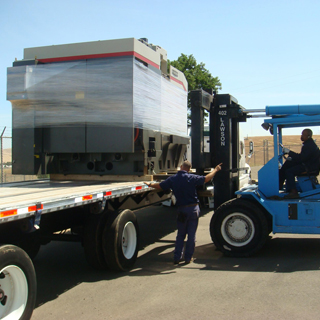
NNSA announced in June that it has removed contaminated excess machine tools at Sandia’s California site by forging an innovative partnership with an outside vendor that saved taxpayers millions.
“After overcoming several disposition challenges, we successfully executed a strategy that resulted in significant savings to NNSA and American taxpayers,” says Randal Scott, NNSA’s deputy associate administrator for Infrastructure and Environment. “The removal of the contaminated tools at Sandia/California is another example of NNSA’s commitment to turning a Cold War-era nuclear weapons complex into a 21st century nuclear security enterprise.”
Sandia/California’s Bldg. 979 housed machine tools that had been used to support a wide array of research and development projects since the early 1990s. Ken Buck (8236) and Jerry Fordham (8236-2) were the owners of the operation and equipment and initiated the clean-up project in 2007.
IN A PARTNERSHIP among Sandia, NNSA, and Oak Ridge-based Toxco Inc., a suite of machine tools contaminated during their period of mission-related work has been safely removed from the California site, saving taxpayers some $4 million in recycling and disposition costs. Here, the crated tools are loaded onto a truck for transport to Toxcos facility in Tennessee. (NNSA photo).
Toff Garcia (8517) negotiated all aspects of the clean-up activities, while others such as Wendy Dolstra (8516), Kelly Wendell (8236-2), and Pam Williams (8525) also played critical roles. “It was a real team effort, one that we had to have in order to pull this off,” Toff says.
The R&D work supported by the machine tools was completed in recent years, resulting in a determination that the tools were no longer needed by DOE and NNSA and could be disposed of as excess.
“It was important that we execute a disposition plan for a number of reasons, such as potential regulatory concerns and the loss of revenue-generating space,” explains Ken. “But first and foremost, the contaminated equipment represented unnecessary health and safety risks to Sandia personnel.”
NNSA selected Toxco Inc. of Oak Ridge, Tenn. — a Nuclear Regulatory Commission-licensed vendor — for its ability to receive the equipment for processing and release from regulatory control. One of the world’s leading battery recyclers, Toxco and its facilities are approved and permitted, operating under strict guidelines from state and federal environmental protection agencies.
Potential reuse of the tools was complicated because of contamination, but the cost for disposing the tools at the Nevada Test Site was estimated at more than $4 million. Looking to most efficiently use taxpayer dollars, Sandia contacted NNSA’s Office of Infrastructure and Environment to determine if there was a lower-cost method to dispose of the tools.
Toxco agreed to take title to the equipment “as-is, where-is” at Sandia and transport the items to its licensed facility in Tennessee for reclamation. The total cost of this plan is roughly $70,000, and the vendor provided all transportation, processing, and waste disposal services necessary to disposition the equipment either as waste or reusable equipment.